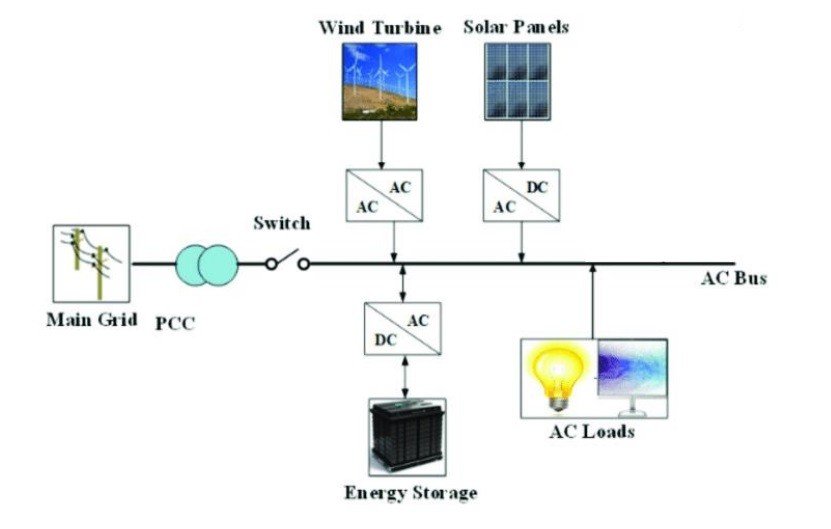Microgrids are small-scale power systems that can operate independently or in parallel with the main grid. They are becoming increasingly popular due to their ability to provide reliable and efficient power supply, as well as their potential to integrate renewable energy sources. Control of microgrids is a crucial aspect in ensuring their proper functioning and optimal performance. It involves the implementation of various control strategies and algorithms to manage the power flow, balance supply and demand, and maintain system stability. Effective control of microgrids is essential for maximizing the benefits of these systems and promoting their widespread adoption as a sustainable energy solution.
Modes of operation of microgrids
Microgrids can operate in several different modes depending on the power demand, the availability of energy sources, and the connection status with the main grid. Here are some common modes of operation:
Grid-connected mode: In this mode, the microgrid is connected to the main grid and can exchange power with it. The microgrid can import power from the grid when the demand exceeds the local generation, and it can export excess power back to the grid when the generation exceeds the demand.
Islanded mode: In islanded mode, the microgrid operates in isolation from the main grid, relying solely on its own energy sources to meet the demand. This mode is useful in situations where the main grid is unavailable or unreliable, such as during a power outage.
Challenges in control of microgrids
The control of microgrids presents a number of challenges, including:
Control complexity:Microgrids are complex systems that involve multiple components and control mechanisms. This can make the design and implementation of control strategies challenging.
Dynamic system behaviour:Microgrids are subject to frequent changes in power demand, power supply, and system topology. The dynamic behaviour of the system can make it difficult to maintain stable system operation.
Communication and coordination:The effective operation of a microgrid requires communication and coordination between multiple components and subsystems. This can be challenging, particularly in systems with distributed energy resources that may be located in remote or inaccessible locations.
Islanding and reconnection:The control of microgrids must account for the possibility of islanding and reconnection. Detecting and responding to these events requires rapid and accurate control strategies.
Cybersecurity:Microgrids are vulnerable to cyber-attacks, which can compromise the security and reliability of the system. Ensuring the cybersecurity of a microgrid requires robust control strategies and secure communication protocols.
Grid connected mode of Solar PV
Grid-connected mode of operation is one of the most common modes for solar PV systems, where the solar panels are connected to the main grid through a grid-tied inverter. In this mode, the solar PV system generates electricity from sunlight during the day and feeds it into the grid. If the solar panels generate more electricity than is being consumed locally, the excess electricity is exported to the grid. Conversely, if the local demand exceeds the solar generation, the electricity is drawn from the grid. The grid-tied inverter used in this mode not only converts the DC power generated by the solar panels into AC power but also regulates the voltage and frequency to match that of the grid. This ensures that the electricity generated by the solar PV system is synchronized with the grid and can be used directly by local loads or fed into the grid to offset the consumption of other users.

Figure 1. Block diagram of grid-connected PV system (source: https://doi.org/10.1049/iet-rpg.2020.0317)
Power electronics play a critical role in controlling the power flow of solar PV systems, with a DC-DC converter and a DC-AC inverter with a filter being two essential components. The DC-DC converter is controlled to operate in maximum power point tracking (MPPT) functionality to optimize the solar panel output and extract the maximum amount of power from them. The DC-AC inverter converts the DC power from the converter into AC power that can be fed into the grid. The inverter is controlled using a three-loop control strategy that regulates the power injection to the grid by controlling the voltage and current of the AC output to match the grid voltage and frequency while maintaining its input dc voltage. The amount of power injection is varied in-order to maintain the inverter input dc voltage. The DC-DC converter allows for the efficient use of solar energy by maintaining the voltage and current at the optimum levels, while the DC-AC inverter ensures that the AC output is synchronized with the grid and of high quality. The three-loop control strategy provides precise and stable control of the inverter, making it suitable for a wide range of applications. Overall, the converter-inverter based control strategy is a key component of modern solar PV systems that are integrated into the grid.
Synchronisation of solar PV for grid connected mode of operation of microgrids
Synchronization of solar PV to the grid is an important step in the operation of a grid-tied solar PV system. The synchronization process involves aligning the output voltage and frequency of the solar PV system with those of the utility grid. This is necessary to ensure safe and reliable operation of the system and to prevent any damage to the equipment. To synchronize a solar PV system to the grid, the output of the inverter must be synchronized with the grid voltage and frequency. This is typically achieved using phase-locked loop (PLL) control. The PLL control continuously measures the grid voltage and frequency and adjusts the output of the inverter to ensure that it is synchronized with the grid.
Once the solar PV system is synchronized with the grid, it can start injecting power into the grid. The inverter continuously monitors the grid voltage and frequency to ensure that it remains in sync with the grid. If there are any changes in the grid voltage or frequency that may affect the synchronization of the solar PV system, the inverter will adjust its output to maintain synchronization.
Synchronous reference frame Phase-Locked Loop
Synchronous reference frame Phase-Locked Loop (PLL) is a type of PLL used in power electronics for grid-tied inverters and other power converters. It is used to generate a control signal that is 0synchronized with the grid voltage, allowing the inverter to inject power into the grid at the same frequency and phase as the grid voltage.
The synchronous reference frame PLL is based on the principle of transforming the grid voltage signal into a rotating reference frame that rotates at the same frequency as the grid voltage. The reference frame is called the synchronous reference frame or dq reference frame. The PLL then measures the phase difference between the dq reference frame and the output voltage of the inverter.
Synchronous reference frame PLL is widely used in grid-tied inverters and other power converters because it provides accurate and reliable synchronization with the grid. It is particularly useful in applications where there are high levels of harmonic distortion in the grid voltage or where there are frequency variations due to changes in the grid conditions
Islanded mode of operation of microgrid
Islanded mode control is a crucial aspect of microgrid operation, especially in areas where power outages are common. When a microgrid is disconnected from the main grid and operating in islanded mode, it must rely solely on its own distributed energy resources to meet its power needs. This can include sources such as solar panels, wind turbines, and energy storage devices such as batteries. Islanded mode control involves managing the power flow within the microgrid to ensure that there is a balance between the supply and demand of power, and that the voltage and frequency of the power supply remain stable.

Figure 2. Islanded Microgrid (source: https://doi.org/10.3390/su13169301)
To achieve this, advanced control systems are necessary, capable of detecting the transition from grid-connected to islanded mode and automatically adapting to the new operating conditions. The control system must be able to manage the power generation and storage devices to ensure that the energy balance within the microgrid is maintained. The challenge in islanded mode is that the microgrid may not have sufficient power generation capacity to meet the demand at all times. Therefore, the control system must be designed to manage the load shedding and prioritization of critical loads to ensure that there is no power outage.
The islanded mode control also involves maintaining stability in the power supply. The voltage and frequency of the power supply must be maintained within acceptable limits to ensure that the connected loads operate properly. This requires the control system to be capable of monitoring the voltage and frequency of the power supply and adjusting the power generation and distribution accordingly.
Overall, islanded mode control is critical for maintaining a stable and reliable power supply within the microgrid. Without proper control, the microgrid can suffer from power outages, damage to equipment, and reduced efficiency. Therefore, the development of advanced islanded mode control systems is essential for ensuring reliable power supply in remote areas or in regions with an unreliable power grid.
The Energy Consortium at IIT Madras, under the direction of Prof. Krishna Vasudevan, conducts active research in the field of microgrids. The research focuses on decentralized control of distributed energy resources, integration of energy storage systems, control of power quality through harmonic elimination, and protection schemes. To learn more about the research, it is recommended to read the latest publications ( https://ieeexplore.ieee.org/author/37293260600)
Author – Vijaymahantesh Surkod, PhD Scholar, IGCS Research Programme on Sustainable Power Engineering – Phase II, Dept. of Electrical Engineering, Indian Institute of Technology, Madras



